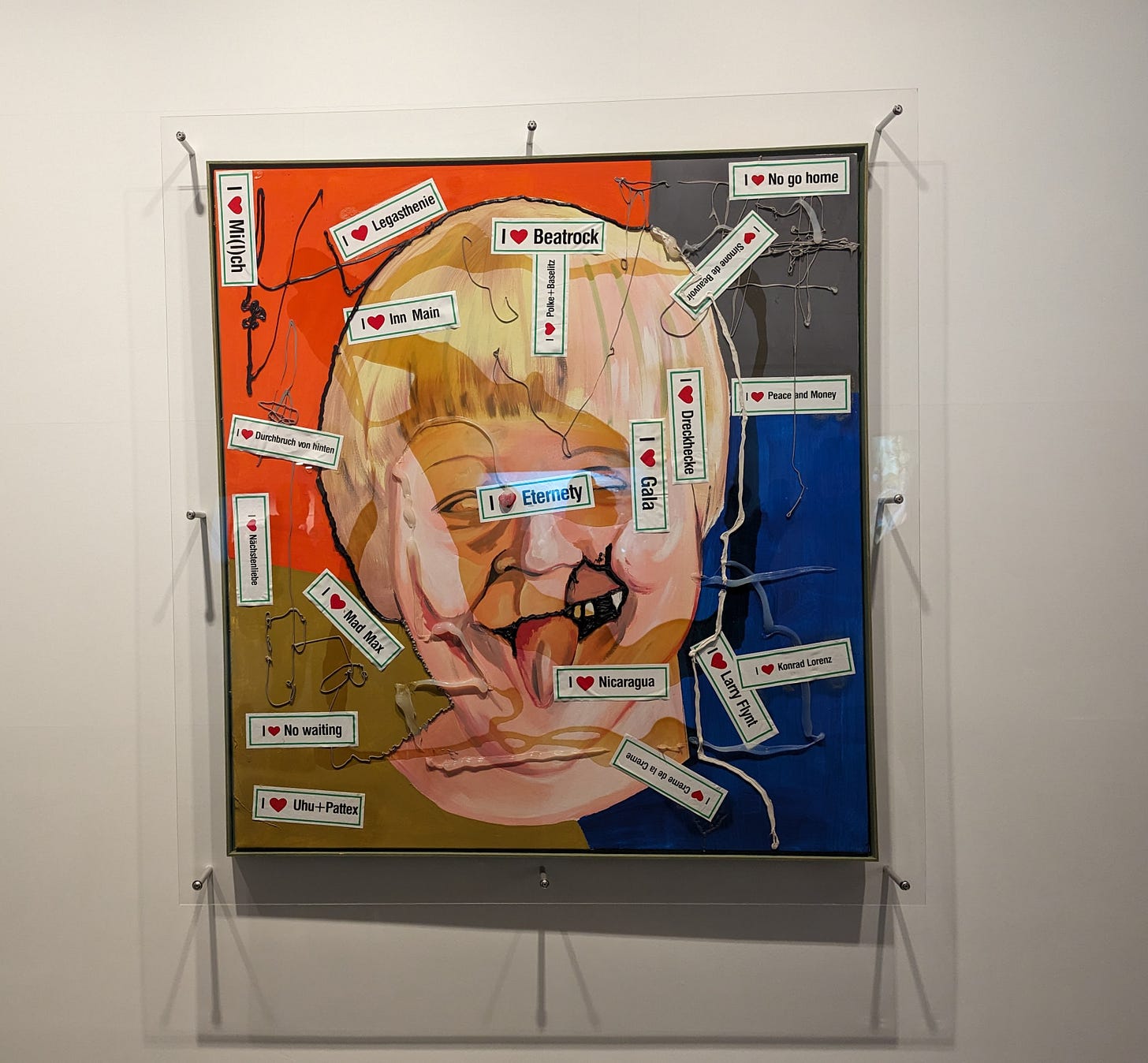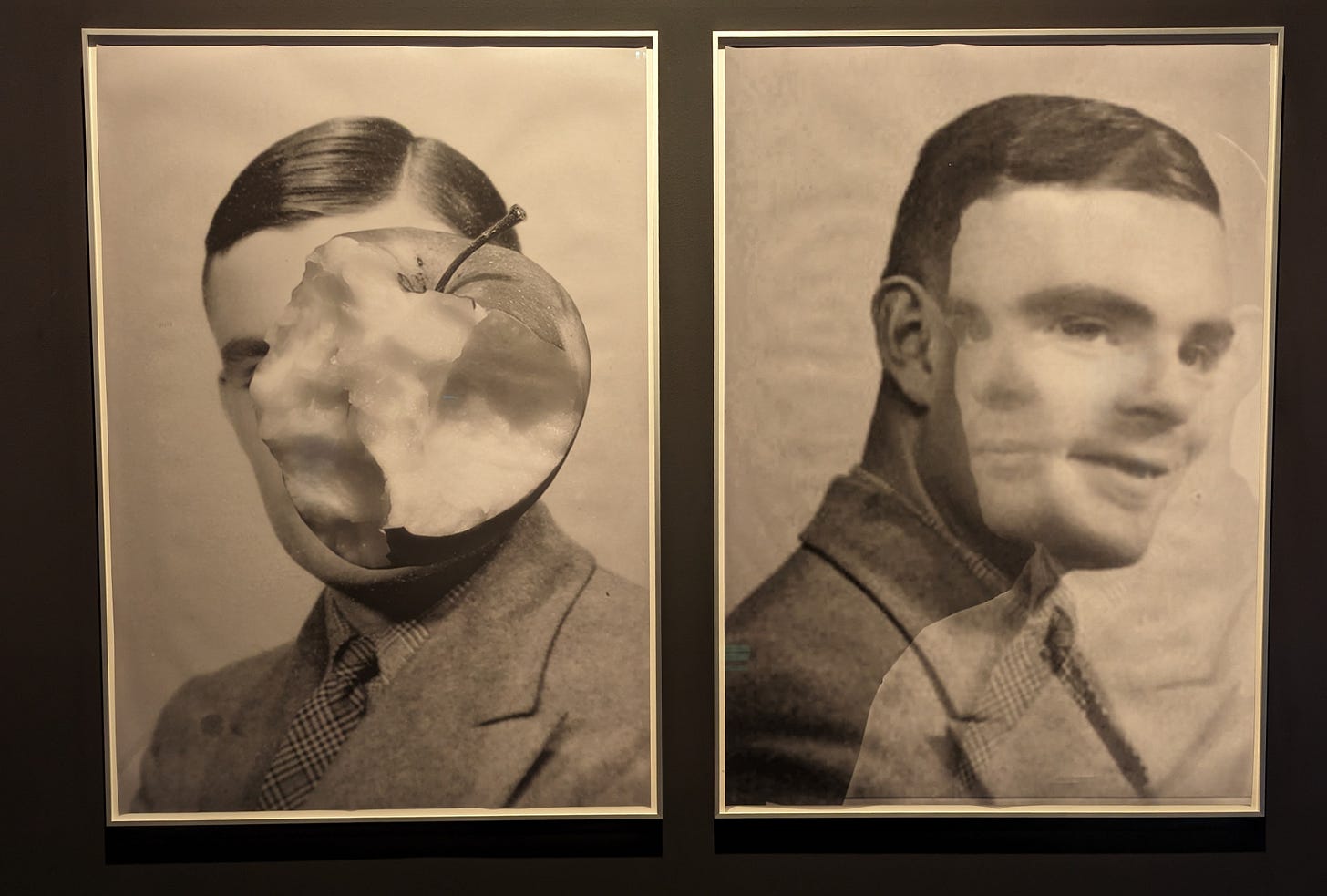TK #10: The pursuit and punishments of creativity
TK, short for “To Come,” in publishing and journalism is used by editors to mark missing information. This newsletter is repository of work "to come". TK #10 is a note on two exhibitions in Denmark.
Thoughts from two art exhibitions in Denmark: ‘Rebel Rebel’ by Iranian-British artist Soheila Sokhanvari at Aros in Aarhus, and ‘The Irreplaceable Human – Conditions of Creativity in the Age of AI’ at Louisiana Museum of Modern Art in Copenhagen.
Art is food for a hungry soul and heart. At least, on those rare occasions, I can fathom what the artist has attempted to put on the day’s menu. I don’t intend to sound “artsy-fartsy”, as people in India might say. But there’s not much I can do–apart from writing or gushing over what I’ve seen, which I will attempt to do today to illustrate how deeply it moves me when I see an exhibition, a painting or a piece of art that speaks to me. Art answers a few questions deep within, in exchange for doubts and half-formed whispers of meaningful thoughts.
A month and a half in Denmark and I had the pleasure of visiting two of the best modern art museums in the Nordic region: Aros in Aarhus and the Louisiana Museum of Modern Art in Copenhagen.
I am still thinking about both. In all, I saw close to half a dozen exhibitions at Aros and Louisiana. But I’ll recap two exhibits that stood out. Both were about creativity and the grounds in which it takes root, which is one of the many things that make humans different from other life on earth. But the constraints that both exhibitions explored were vastly different… or maybe not.
Creative pursuits punished by the system and the state
Rebel, Rebel by Soheila Sokhanvari
Sokhanvari was born in Iran in 1964 and moved to Britain as a teenager to study. She now lives in the UK.
The exhibit’s self-description: “Mixing Islamic geometries, western pop references, and classic portrait paintings, Iranian artist Soheila Sokhanvari (b. 1964) pays an extravagant, hyper-political, and heartfelt tribute to the significant courage of female icons from pre-revolutionary 1970s Iran.”
Sokhanvari’s miniature portraits capture 21 Iranian women once celebrated in the performing arts, music and other creative industries at the height of their glory. They stare at us, as if posing for a magazine photoshoot, and demand our attention.
The website reads:
”The exhibition title, Rebel Rebel, borrows from David Bowie’s 1974 cult song to remind us that these women pursued their careers in a culture enamoured with Western art and style but not its freedoms.
The title also serves as a lament to the fate of these women. After the Iranian Revolution of 1979 and the subsequent establishment of a conservative Islamic theocracy, they were left with a stark choice: to renounce any role in public life, or to be forced into exile.”
Rebel, Rebel fuses cultures separated by ideologies, space and time. The centuries-old artistic tradition of egg tempera painting is used to immortalise female pop culture icons of 20th century Iran. It is a homage to Sokhanvari’s heritage and condemnation of the trials and tribulations these women faced.
Sokhanvari celebrates them, but it leaves me sad: we know they are later shunned, condemned or punished for their artistic genius. I am enamoured, curious and excited for their stardom. But there’s little suspense and too many spoilers (I may not know the names of all the 21 women but I know it doesn’t end well for many of them: world history, the media, the pamphlet and the note at the start at the exhibition prime you for the reality). There aren’t many happy endings. Click here for Sokhanvari’s website and picture gallery.
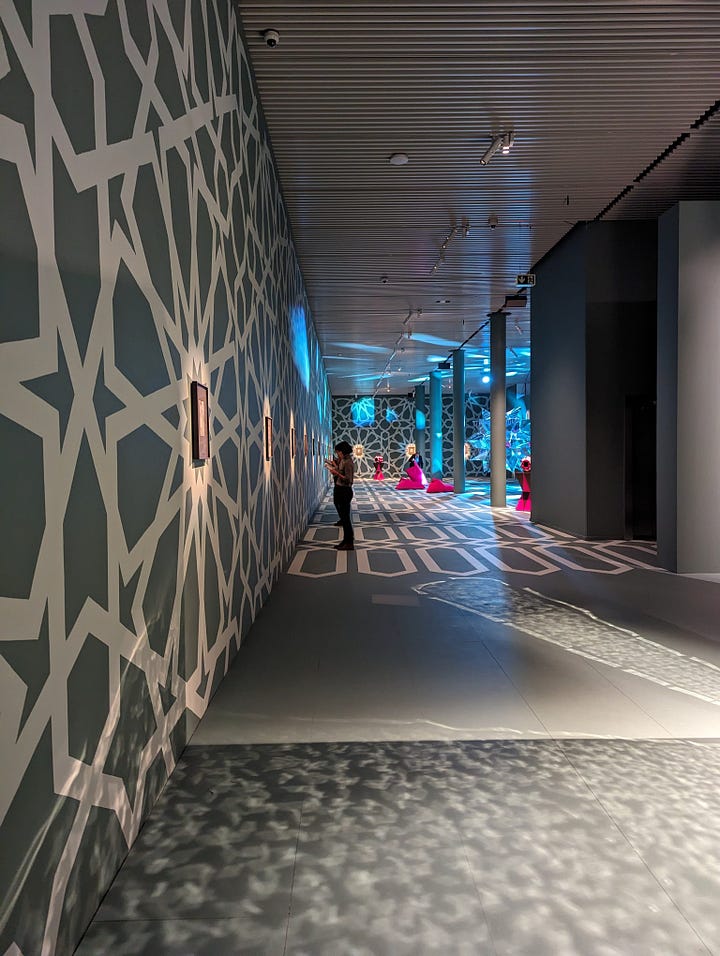
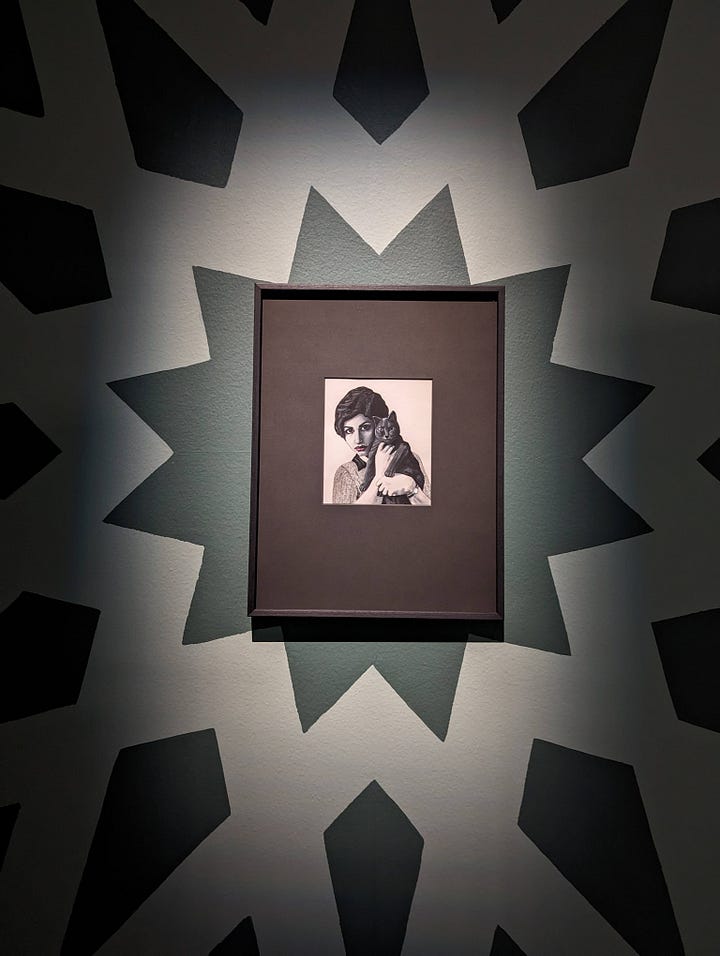
Yet Sokhanvari has anticipated this. I wasn’t allowed to stay sad. The miniature portraits are hung against a hand-painted mural of Islamic patterns. There’s also a soundtrack of songs by celebrated Iranian singers from the mid-20th century. It is illegal to broadcast female singers in Iran. Rebel, Rebel turns into a quiet admiration of the women pop stars and their defiance.
The ultimate effect? Rebel, Rebel immortalises the legacy of these Iranian women, and reminds us that freedom is an essential ingredient for the pursuit of creativity—of any kind.
Creative pursuits shaped by technology and technocracies
The Irreplaceable Human – Conditions of Creativity in the Age of AI by 60 artists
We talk a whole lot about artificial intelligence today without really understanding what it means. When I say this, I don’t mean what it means to create, run and operate an AI algorithm or product. I mean what it means for us. It is easy to walk away with an “aah, enough, not this again”. But to engage and to reflect on what really landed us here, and how is a rather difficult challenge. Because then we realise that all we have been doing for the last several centuries has led us here.
Have you ever paused to think if you are really creative or free? Where does that creativity come from? What helps it thrive? Yes, depending on where you are reading this from you may or may not be free of authoritative regimes. Yet we are controlled by technology. A victim of our illusionary ‘free’ will. What if, right from our childhood, we were never really ‘free’, we were constantly being shaped into a productive citizens. Our days and nights measured, our life carefully orchestrated, and we were constantly coerced by forces beyond our control.
We replaced handlooms for mass-produced textiles several centuries ago, because it was effective and efficient. Thousands of creative jobs were gone in one part of the world, and mindless, menial jobs were created in another. Should we then resist and worry that our ‘creative jobs’ are being replaced by AI now? What is it really to be creative in this day and age?
I had a million such thoughts (some quite uncomfortable) when I was watching these exhibits. I didn’t have many coherent explanations about and descriptions of this impressive and fantastic exhibition, but I am leaving some pictures below. I do wish I had gone with friends [I did, but they liked the exhibits] and then spent an entire evening discussing it. Here’s a brief description I picked from the Louisiana site:
This exhibition aims to “…create the foundation for a conversation about the role of creativity in our society – and thus also for a discussion about what is really valuable to us.”
“The exhibition The Irreplaceable Human–Conditions of Creativity in the Age of AI is divided into two primary tracks. The first part consists of three chapters essential for understanding how we develop creativity today: Childhood, Work, and Artificial Intelligence.
The second part of the exhibition – divided into two chapters, ‘Time’ and ‘Cross-pollination’ – revolves around garnering respect and appreciation for actions and abilities that are often considered a waste of time, redundant, unimportant, bad for business, or just difficult to evaluate. Altogether, creativity here emerges as something inherently crucial for our society’s positive development and survival. As a whole, the exhibition argues that we need to take the long view: to prepare the ground beyond what seems immediately lucrative, and to dare to believe that something new and valuable will emerge from it.”
Photos from the exhibition [caption is pasted verbatim from exhibit labels]:
Trevor Paglen’s ‘From Apple to Abomination
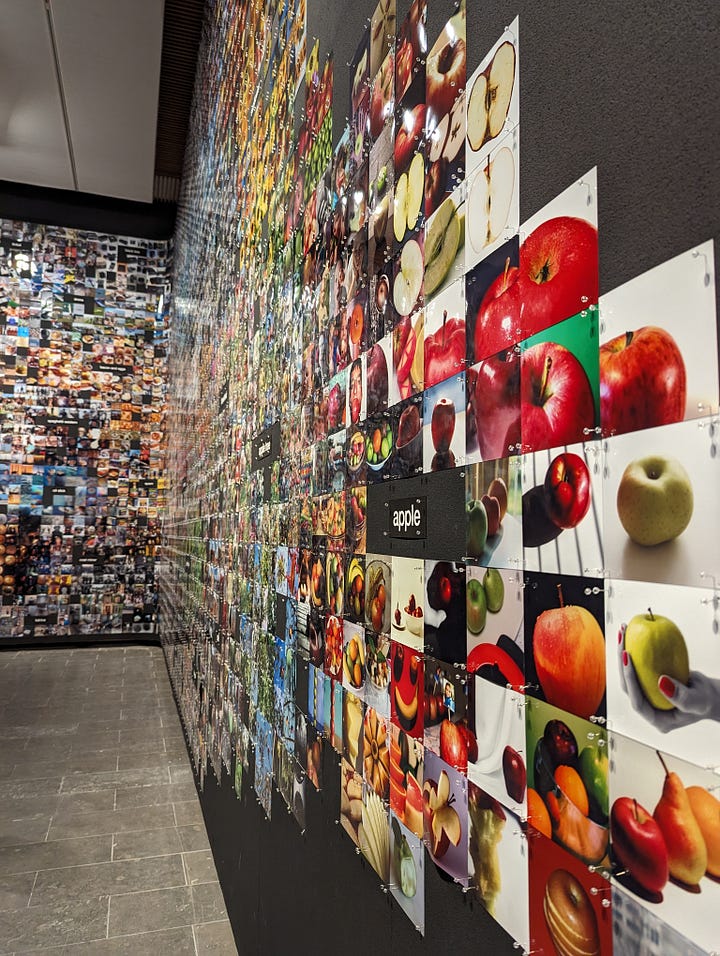
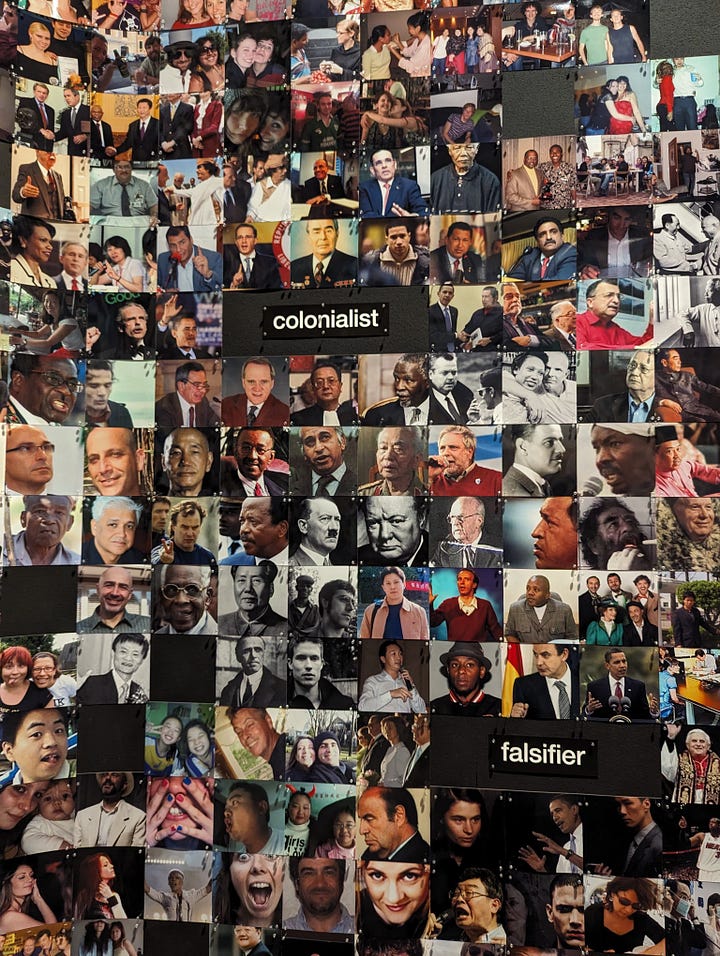
This work is composed of more than 13,000 images from ImageNet, a training set with more than 20,000 categories totalling over 14 million images. To teach a computer to recognize images, an army of digital workers first have to tag the images with words describing what is in them. As a result, the classifications perpetuate people's assumptions and biases about the world and each other. Image classification may seem innocent enough when it involves teaching a machine to recognize, say, an apple. But more abstract and relational categorizations become problematic when digital workers are tasked with teaching the machine what and who belong under categories like "abnormal" or "abominable," The work spotlights the systems commonly inherent in such software and affecting us all, questioning the arbitrary connections between images and words, and the problems they create.
Martin Kippenberger’s Kaputtes Kind (Broken Child)
The work Kaputtes Kind by the German artist Martin Kippenberger is a pre-digital work that anticipates the online world's nonstop opinionating, familiar from social media likes, here in the shape of stickers for the car's bumper. A picture of a child sticking out its tongue, swiped from the Austrian-Irish artist Gottfried Helnwein, has been augmented with an array of stickers with statements about loving everything from dyslexia to Nicaragua to peace and money. According to the title, Kippenberger's child is broken and like always with this artist, the title holds various meanings. The child as a motif is broken, because the artist has covered it with stickers and at the same time the child is broken because (most) statements are incompatible with childhood. The broken child is perhaps a grownup.
Henrik Olesen’s work on Alan Turing
In his work, the Danish artist Henrik Olesen has repeatedly returned to the English mathematician Alan Turing (1912- 1954). Olesen's interest springs both from Turing's status as a computer pioneer and from his sad fate. Despite his crucial contribution to the Allies during World War II, Turing was persecuted and mistreated by the British government for being gay. As a direct result, he committed suicide in 1954 by eating a poisoned apple. Today, Turing's story presents a grim example of an individual crushed by oppressive state politics. In one image, Olesen represents Turing as a ghost-like figure, whose story continues to haunt us today, reminding us that any system, algorithm or law is defined by its creator's norms, ideologies and vision of humanity.
Do check out select examples of the exhibits here. The exhibition also had six films, which can be viewed here.
That’s it for this TK. As usual, I’ve missed the promise of a fortnightly newsletter. Since I can’t seem to keep that promise, please accept my apologies but the T&Cs are changing: TK will now be delivered when I finish an edition, hopefully twice in a month.
Best,
Mahima Jain




